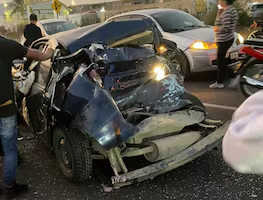Más Información

ONGs piden a Sheinbaum contemplar propuestas para seguridad vial; más de 16 mil personas mueren por accidentes

De la Fuente se reúne con representantes de 9 países de América Latina; coordinan acciones de migración

Mexicanos en EU entregan a SRE propuestas para defensa de los migrantes; destacan derechos de las mujeres

Colosio critica comités de evaluación de elección judicial; oficialismo escogerá a sus candidatos, acusa
The street version of fentanyl blamed in the deaths of thousands of Americans is also threatening police officers, forcing changes in long-standing basics of drug investigations, from confiscations to testing and undercover operations, law enforcement officials say.
Overdose deaths have surged as drugs such as heroin, cocaine and counterfeit prescription pills are now commonly laced with fentanyl to increase potency, though drug investigators say it is increasingly sold by itself, too. A speck the size of a few grains of salt can potentially kill a 250-pound (113-kilogram) man, said Tommy Farmer, special agent in charge of the Tennessee Bureau of Investigation.
Fentanyl can be absorbed through the skin or inhaled if it becomes airborne. Because such a small amount can be deadly, police agencies big and small are changing the way they go about keeping officers safe. James Shroba, special agent in charge of the Drug Enforcement Administration's office in St. Louis, said agents are even trained in how to give themselves the anti-overdose Narcan in case of accidental exposure to fentanyl because "if they actually touch it or inhale it, they could die."
"This is a whole different dynamic of how we process evidence," Shroba said.
Fentanyl, a synthetic opiate, can be legally used, typically in a patch, by those in severe pain, such as end-stage cancer patients. The street version, which is mostly made in China or Mexico, comes in various forms - tablets, patches, powder, spray. The DEA says it is 40 to 50 times more potent than heroin. Experts say its potency can vary because it is haphazardly manufactured, creating the risk of instant death. Music legend Prince died of a fentanyl overdose in April, though authorities are still investigating whether it was obtained legally or illegally.
Fentanyl and other synthetic opioids were involved in 5,554 overdose deaths in 2014, a 79 percent increase over 2013, according to U.S. Centers for Disease Control and Prevention data. Statistics for 2015 and 2016 aren't available, but narcotics officers say the problem is getting worse.
The danger extends beyond the user. The potency makes it potentially deadly for first-responders. No police deaths have been blamed on fentanyl, but there have been close calls.
Atlantic County, New Jersey, detective Dan Kallen and colleagues were searching a home in August when they found a box full of drug paraphernalia, along with a bag of white powder. Kallen and detective Eric Price opened the bag and performed a field test to determine what it was. A small amount became airborne as Kallen closed up the bag, he said.
Suddenly, both detectives became ill.
"It hit us like a ton of bricks," Kallen, 40, said. "It became very difficult to breathe. Our hearts were racing. We were nauseous, close to blacking out.
"I felt like, 'Holy crap, I'm going to die right now,'" Kallen said.
Both detectives were rushed to the hospital and made full recoveries. Testing later showed the confiscated drugs were cocaine and heroin mixed with fentanyl.
"We got the party platter," Kallen said.
Fighting the drug trade is inherently dangerous. In addition to the threat of violence posed by drug lords, distributors and dealers, narcotics officers face risks such as inadvertent needle pricks and exposure to deadly chemicals and fires from methamphetamine production.
Fentanyl is a game-changer, though, many leading law enforcement officials told The Associated Press.
"We definitely see it as the next big danger," Farmer said. "With fentanyl, if the officer is simply patting somebody down, or if he's getting a little bit out to try to do a field test and it accidentally comes in contact with his skin or the wind blows it in his face, he could have a serious problem."
The DEA issued a memo this month urging police to use caution from the outset of a stop. Officers should wear protective gloves before reaching into a suspect's pockets in order to avoid skin contact with loose fentanyl, and wear masks to protect their lungs in case it becomes airborne. The DEA discouraged field testing of drugs, saying confiscated materials should be sent straight to a lab.
The drug is also affecting undercover work, which is the basis of many investigations.
Lt. Jason Grellner of the Franklin County (Missouri) Sheriff's Department said undercover officers are being told to accept drugs in baggies or aluminum foil, not directly by hand.
"Any number of things can occur and kill you," said Grellner, who is also the president of the Missouri Narcotics Officers Association.
Sgt. Mike Toles, of the Indiana State Police, agreed.
"We're telling our people, 'If someone is telling you this is methamphetamine or heroin, don't take their word for it. Assume it is fentanyl," Toles said.
The DEA keeps Narcan at the ready during undercover operations, with officers monitoring from afar ready to assist the undercover officer in case of exposure, Shroba said.
The concerns extend to police dogs, which can be imperiled if they get too big a whiff of fentanyl. The DEA memo urges handlers to be careful with their dogs.
"They're going to take in a larger dose because that's how they're trained to sniff it out," Shroba said.
Kallen, who has been a detective for 15 years, said his encounter forever changed the way he does his job.
A majority of our stuff has fentanyl in it," Kallen said. "We don't even field test. It's not worth it to open up those bags and put that stuff in the air or get it on your skin."






